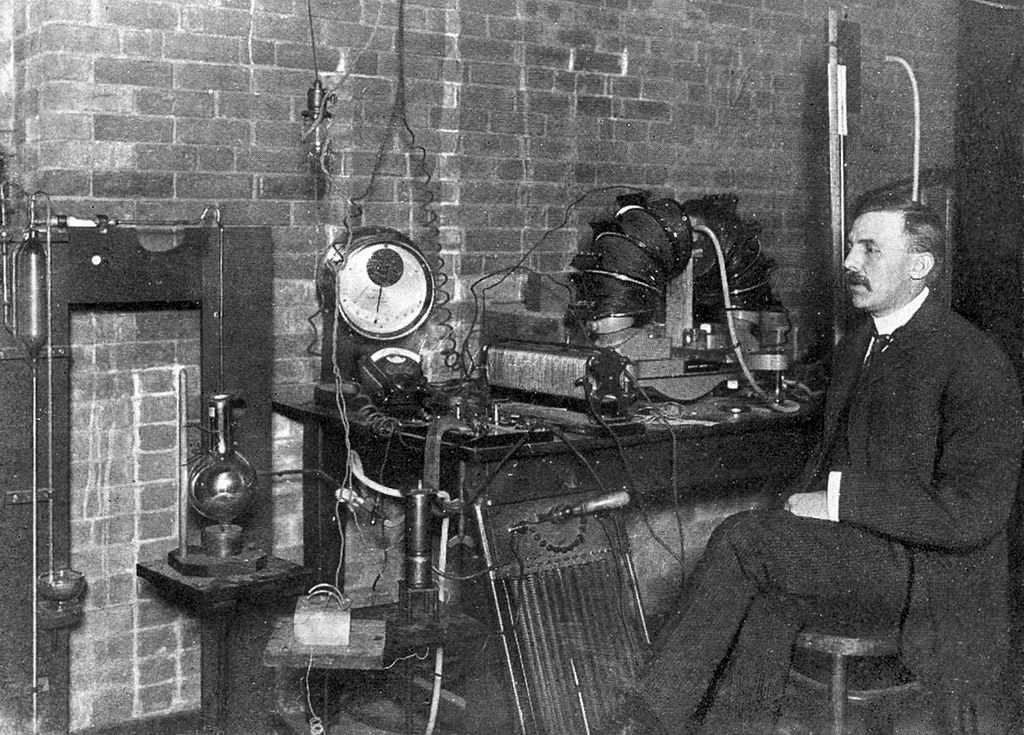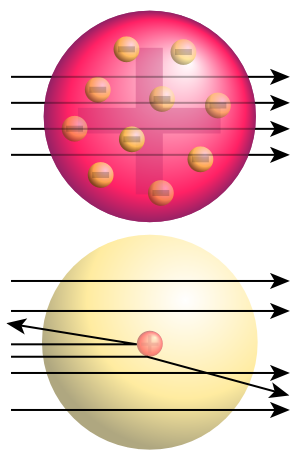Ernest Rutherford
Claimed by pestrada8 on November 9th
Personal Life and Education
Ernest Rutherford was born in New Zealand, specifically at Spring Grove in rural Nelson, on August 30th 1871. He was the fourth child out of twelve, and was born in a country that by the time had had only fifty years of European settlement away from the British Colonies. His mother a teacher, and his father, a wheelwright, engineer and later on a flax-miller, provided him a good education. When he was ten years old he received his first science book, which led him to carry out one of his first experiments, a miniature firing cannon, which exploded without injuring anyone. In 1887, he won a Scholarship to attend secondary school and two years later he won one of the ten scholarships available on a national level to attend the University of New Zealand. A few years later he graduated with a BA in Pure Mathematics and Latin (which were both mandatory), Applied Mathematics, French, English and Physics. He won the only Senior Scholarship in Mathematics available in New Zealand, which led him to return to School to pursue a Masters in Mathematics and Physics. As an undergraduate he conducted an experiment inspired by Tesla, to determine if iron was magnetic when exposed to high frequencies of magnetizing currents. In 1893 he obtained his Master of Arts degree in Mathematics and Mathematical Physics and Physical science, which he earned with double First Class Honors. He tried being a permanent School teacher and considered the field of Medicine, but finally returned to College to take a BS degree in geology and chemistry, where he continued exploring and experimenting with magnetism.
Scientific Contributions
Alpha and Beta Particles
Among the most important scientific contributions of Ernest Rutherford are the discovery of the alpha and beta radiation. In 1898, Rutherford started carrying out experiments in which he allowed radiation from uranium to pass through an increasing number of metal foil layers, and he observed that beta particles had a bigger penetrating power than the alpha rays. He paid close attention to the movement of these particles in a magnetic field, from which he concluded that alpha particles were positively charged. Moreover, by measuring the mass to charge ratio he hypothesize that the alpha particles were helium ions that had a positive 2 charge. With the help of his co-worker, Frederick Soddy, who would later win a Nobel Prize, Rutherford concluded that the alpha particles were atomic in nature, that were produced when larger atoms disintegrated- becoming slightly smaller atoms- and that alpha particles were indestructible. We will now explore his main scientific contribution, the discovery of the atom’s nucleus and proton.
Gold foil experiment
What Ernest Rutherford is most well-known is for his conclusions of the Gold-foil experiment. This experiment consisted in throwing alpha particles through a gold foil to observe the behavior of the particles. What Ernest discovered was that almost all alpha particles passed straight through the foil, but some of them were deflected back as if they had hit something that made them rebound. Ernest concluded that the reason why this happened was that the atom, despite the widely accepted plum pudding model, in fact was almost all empty space and that had a positively charged nucleus at the center, which was the one repelling the alpha particles. This gave birth to a new nuclear model, which is still today the most widely accepted model. The nucleus of the atom he claimed to have a diameter of around 10e-14 meters. Later, the negative lumps that at the beginning led to plum pudding model were discovered to be electrons, which are negatively charged, that orbited the nucleus with a radius of around 10e-10. This confirmed Rutherford’s conclusion that almost all of the atom was empty space. After this discovery, he carried out further experiments to discover what the nucleus was made of. In 1919, he claimed that the nucleus was made of protons. The experiment he carried out to make this conclusion consisted in placing a source of alpha radiation inside a cylinder of nitrogen gas that had one open end covered with a sheet of aluminium foil. Outside the opening, he placed a screen, were flashes of light were observed. These flashes were caused when particles hit the screen, but since the aluminium foil didn’t allow the alpha particles to pass through, there had to be another, smaller particle hitting the screen. With the help of two of his research students, Rutherford took measurements of the deflection angles of the particles and calculated that the proton was smaller than most nuclei, and had a positive charge equal in magnitude to that of electrons. Analyzing the distribution of the deflected alpha particles, which was different for different forces (i.e: magnetic, hard sphere, etc) he was able to assure that the nucleus was positively charged.
Click on the following link to enjoy a Rutherford Scattering simulation! https://phet.colorado.edu/sims/rutherford-scattering/rutherford-scattering_en.jar
J. J. Thomson had modeled the atom as a sphere in which positive charge and mass were evenly spread. Electrons orbited within the positive sphere. This was called the plum pudding model.
The results of the gold foil experiment allowed Rutherford to build a more accurate model of the atom, in which nearly all of the mass was concentrated in a tiny, dense nucleus. Most of the atom’s volume was empty space. The nucleus was like a fly floating in a football stadium – remembering of course that the fly was much heavier than the stadium! Electrons orbited at some distance from the nucleus. This was called the Rutherford model. It resembles planets orbiting a star.
Nuclear Physics Applications
Ernest Rutherford’s discovery of the nuclear structure of an atom established the ground for nuclear processes using radioactive decay, and thus he is known as “The Father of Nuclear Physics”. He influenced many scientists, in particular Leó Szilárd, who was inspired by Rutherford to think about the possibility of controlling nuclear chain reactions to produce energy. Since his discoveries, nuclear physics took off and opened the door to a myriad applications. Not only nuclear physics is used to provide the US with 22% of its electricity, but it is also used in the medical field (diagnostics, therapy, radiobiology and biomedical tracers), it is used in material analysis (nanotechnology, geology and climate, ion implantation, material structure), in computation and nuclear defense (weapon analysis, long-term storage, functionality, homeland security). Ultimately, his contributions have understand the nuclear processes of fission and fusion and left behind the believed theories of up until the 19th century of atoms being the smallest building blocks of matter. A current example of an investigation following Rutherford’s steps was published in Science News, where the hypothesis that the radius of the proton could be about 4% smaller than thought is being debated.
If you are interested in the topic visit: https://www.sciencenews.org/article/incredible-shrinking-proton
Famous Quotes
“I have to keep going, as there are always people on my track. I have to publish my present work as rapidly as possible in order to keep in the race. The best sprinters in this road of investigation are Becquerel and the Curies.”
“Lord Kelvin had limited the age of the Earth, provided no new source (of energy) was discovered. That prophetic utterance refers to what we are now considering tonight, radium!”
"We haven't the money, so we've got to think"
See also
Further reading
https://www.sciencenews.org/article/incredible-shrinking-proton
External links
http://ocw.mit.edu/courses/physics/8-13-14-experimental-physics-i-ii-junior-lab-fall-2007-spring-2008/ https://phet.colorado.edu/sims/rutherford-scattering/rutherford-scattering_en.jar
References
http://www.famousscientists.org/ernest-rutherford/
https://www.aip.org/history/exhibits/rutherford/sections/alpha-particles-atom.htm
https://en.wikibooks.org/wiki/A-level_Physics/Forces,_Fields_and_Energy/The_nuclear_atom

